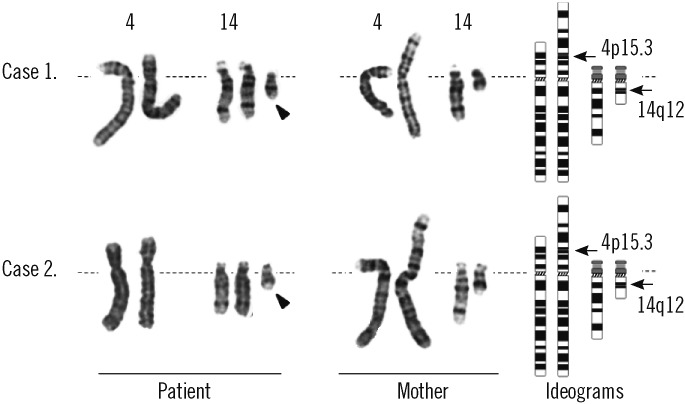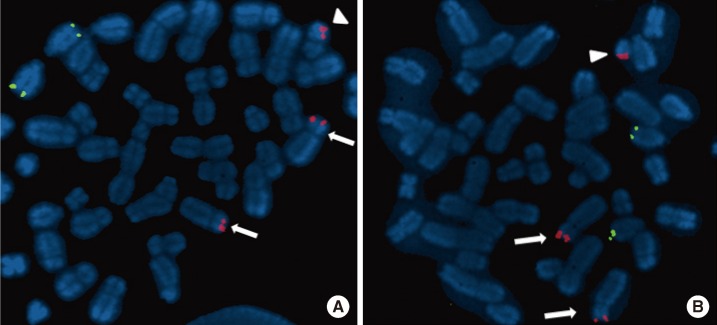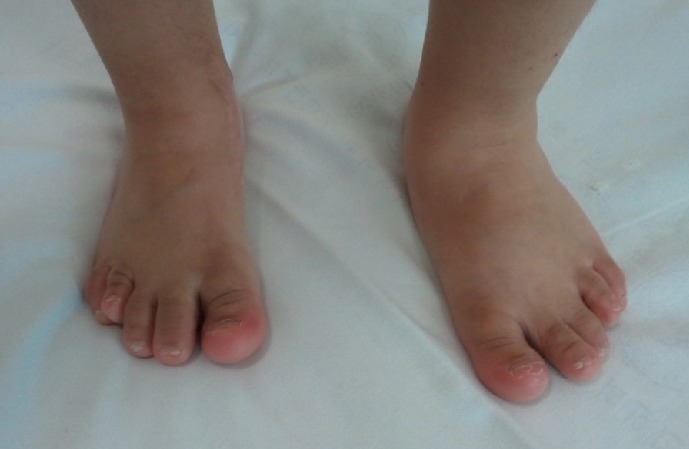Ann Lab Med.
2013 Jan;33(1):69-74. 10.3343/alm.2013.33.1.69.
Two Cases of Partial Trisomy 4p and Partial Trisomy 14q
- Affiliations
-
- 1Department of Laboratory Medicine, Keimyung University School of Medicine, Daegu, Korea. ksksmom@dsmc.or.kr
- 2Department of Pediatrics, Keimyung University School of Medicine, Daegu, Korea.
- KMID: 1781301
- DOI: http://doi.org/10.3343/alm.2013.33.1.69
Abstract
- We present clinical and cytogenetic data on 2 cases of partial trisomy 4p and partial trisomy 14q. Both patients had an extra der(14)t(4;14)(p15.31;q12) chromosome due to a 3:1 segregation from a balanced translocation carrier mother. Array analyses indicated that their chromosomal breakpoints were similar, but there was no relationship between the 2 families. Both patients showed prominent growth retardation and psychomotor developmental delay. Other phenotypic manifestations were generally mild and variable; for example, patient 1 had a short palpebral fissure and low-set ears whereas patient 2 had a round face, asymmetric eyes, small ears, a short neck, finger/toe abnormalities, and behavioral problems.
Keyword
MeSH Terms
Figure
Reference
-
1. Jalbert P, Sele B, Jalbert H. Reciprocal translocations: a way to predict the mode of imbalanced segregation by pachytene-diagram drawing. Hum Genet. 1980; 55:209–222. PMID: 7450764.
Article2. Wilson MG, Towner JW, Coffin GS, Forsman I. Inherited pericentric inversion of chromosome no. 4. Am J Hum Genet. 1970; 22:679–690. PMID: 5518460.3. Patel SV, Dagnew H, Parekh AJ, Koenig E, Conte RA, Macera MJ, et al. Clinical manifestations of trisomy 4p syndrome. Eur J Pediatr. 1995; 154:425–431. PMID: 7671938.
Article4. Tschernigg M, Petek E, Wagner K, Kroisel PM. Mild phenotype due to inverse duplication 4p16.3 - P15.3 including the Wolf-Hirschhorn critical region. Genet Couns. 2002; 13:29–33. PMID: 12017235.5. Zahed L, Oreibi G, El-Amine H, Obeid M, Bitar FF. A new patient with pure trisomy 4p resulting from isochromosome formation and whole arm translocation. Am J Med Genet A. 2004; 128A:60–62. PMID: 15211659.
Article6. Takeno SS, Corbani M, Andrade JA, Smith Mde A, Brunoni D, Melaragno MI. Duplication 4p and deletion 4p (Wolf-Hirschhorn syndrome) due to complementary gametes from a 3:1 segregation of a maternal balanced t(4;13)(p16;q11) translocation. Am J Med Genet A. 2004; 129A:180–183. PMID: 15316961.
Article7. Garcia-Heras J, Martin J. A rec(4) dup 4p inherited from a maternal inv(4)(p15q35): case report and review. Am J Med Genet. 2002; 109:226–230. PMID: 11977183.
Article8. Liehr T, Bartels I, Zoll B, Ewers E, Mrasek K, Kosyakova N, et al. Is there a yet unreported unbalanced chromosomal abnormality without phenotypic consequences in proximal 4p? Cytogenet Genome Res. 2011; 132:121–123. PMID: 20639618.
Article9. Dallapiccola B, Mastroiacovo PP, Montali E, Sommer A. Trisomy 4p: five new observations and overview. Clin Genet. 1977; 12:344–356. PMID: 563312.
Article10. Eggermann T, Gamerdinger U, Bosse K, Heidrich-Kaul C, Raff R, Meyer E, et al. Mosaic tetrasomy 14pter-q13 due to a supernumerary isodicentric derivate of proximal chromosome 14q. Am J Med Genet A. 2005; 134:305–308. PMID: 15723300.
Article11. Lemire EG, Cardwell S. Unusual phenotype in partial trisomy 14. Am J Med Genet. 1999; 87:294–296. PMID: 10588832.
Article12. Monfort S, Blesa D, Roselló M, Orellana C, Oltra S, Cigudosa JC, et al. Duplication of 14q11.2 associates with short stature and mild mental retardation: a putative relation with quantitative trait loci. Am J Med Genet A. 2007; 143:382–384. PMID: 17230491.
Article
- Full Text Links
- Actions
-
Cited
- CITED
-
- Close
- Share
- Similar articles
-
- A Case with Partial Monosomy 6q and Partial Trisomy 14q Derived from Maternal Balanced Translocation
- A Case of Partial Trisomy 14q derived from Paternal Balanced Translocation
- A Cse of Partial Trisomy 10q Syndrome
- A Case of Distal 10q Partial Trisomy Syndrome
- Recurrent Partial Trisomy 1q in Maternal Balanced Translocation t(1;11)(q32;q23)





